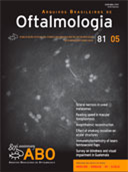Purpose: To study visual acuity, refractive errors, eccentric fixation, and reading performance in patients with toxoplasmic macular retinochoroiditis.
Methods: Twenty-three participants with bilateral toxoplasmic macular retinochoroiditis and 4 with toxoplasmic macular retinochoroiditis in their unique eye were evaluated. Participants reported their eye dominance, confirmed by the Portus and Miles test. Best corrected visual acuity, spherical equivalent refraction, magnification need, and reading speed were measured. Microperimetry (MAIA, Centervue - Padova, Italy) recorded the preferred retinal locus and fixation stability by means of the bivariate contour ellipse area. Fourteen eyes from 14 normally sighted subjects served as controls.
Results: Mean ± SD best corrected visual acuity was better in the dominant eye than in the nondominant eye: 0.9 ± 0.2 (logMAR 0.5 to 1.4) vs. 1.2 ± 0.3 (logMAR 0.6 to 1.7) (p<0.0001, paired t-test). Spherical equivalent myopia of -4.00 or higher was present in 42% of the eyes. Microperimetry was performed in 42 eyes. Eccentric fixation was observed in all examined eyes. In 14 eyes (33%), the preferred retinal locus was placed (in the retina) superior temporal to the macular lesion, in 10 (24%) superior nasal, in 6 (14%) inferior temporal, and in 12 (28%) inferior nasal. There was no significant difference in the distribution of the preferred retinal locus position between dominant and nondominant eyes (p=0.85, Pearson test). There was no correlation between reading speed and the distance between the preferred retinal locus and the estimated original foveal position (r=-0.09; p=0.73), the bivariate contour ellipse area (r=-0.19; p=0.44), or best corrected visual acuity (r=0.024; p=0.92).
Conclusions: Myopia is more prevalent in patients with toxoplasmic macular retinochoroiditis. Reading speed is not dependent on preferred retinal locus position, stability, or visual acuity. Nevertheless, documentation of fixation provides new data on the impact of visual impairment in these patients and may be useful for rehabilitation efforts.
Keywords: Choroiditis; Chorioretinitis; Myopia; Toxoplasmosis, ocular; Reading
